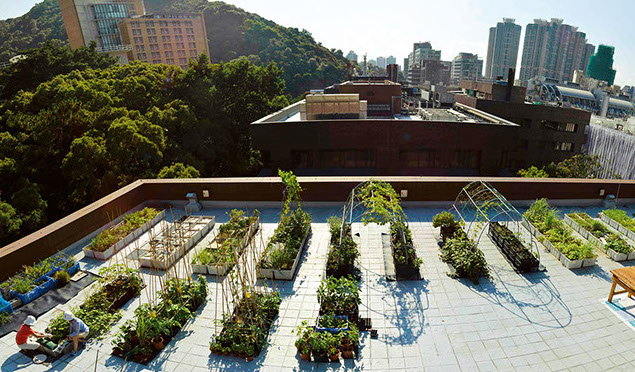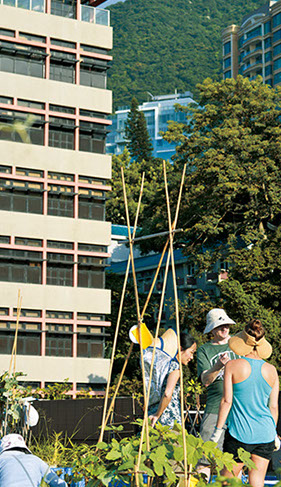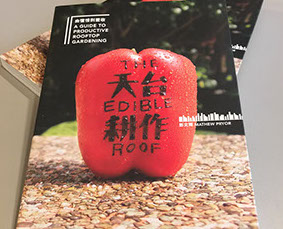Extraction from pamphlets in 19th-century China illustrating children’s kidney being removed.
(Photo courtesy of Princeton Library)

The rooftop garden at HKU’s Runme Shaw Building.
(Courtesy of John Fung)
EDIBLE Roof
Growing your own vegetables makes sense, but in Hong Kong’s urban jungle few have gardens. Now the Division of Landscape Architecture has produced a manual for building and operating a productive rooftop garden that it hopes will not only result in people cultivating their own food but will also bring communities together.

The launch of the book in January marks four years of hard work developing HKU’s own edible roof. Mr Mathew Pryor, Head of the Division of Landscape Architecture, began developing the idea after an external examiner suggested there should be more practical elements to the Landscape undergraduate programme.
“We launched a Landscape Practicum course in which students have to build a landscape project and one of our first thoughts was building a green roof. But, while green roofs have many benefits, they are often not easy to maintain. The idea of building a productive rooftop garden instead came about because I was working with the Feeding Hong Kong food distribution charity at the time and they were looking to add fresh produce to the other foodstuffs they give out.”
Mr Pryor collaborated with Ann Kildahl, HKU’s Sustainability Manager, to find the ideal roof for the project. They chose the roof of the Runme Shaw Building on the Main Campus and, working with Landscape Architecture students, began to develop a 50-square-metre garden. “There were challenges,” said Mr Pryor. “The roof is only accessed by a narrow stairwell and everything had to be taken up by hand. We must have lugged several tons of soil up those stairs! But the garden has been a great success. Students involved in that initial garden have since graduated but some still return to help tend it.”
Next, the General Education (GE) Unit asked if they too could have a garden. “They got another organisation, Time2Grow, involved with that one, and built it alongside ours,” said Mr Pryor. “The two gardens became the basis of the HKU Rooftop Farming Project launched in late 2013. Then there were third and fourth phase expansions, and now the garden is nearly 400 square metres.

![]() In high-rise towers there is a defined community, and people are the essential ingredient in starting and maintaining any garden.
In high-rise towers there is a defined community, and people are the essential ingredient in starting and maintaining any garden. ![]()
Mr Mathew Pryor
Bringing people together
“A core group of eight or ten people tend it daily. While students are responsible for much of it, the volunteers also include colleagues from HKU’s academic and non-academic staff from all over the campus. It has engendered a wonderful community spirit across all areas of the University.”

The rooftop garden brings together students, academic and non-academic staff and alumni of the HKU community.
(Courtesy of John Fung)
And if the labour is shared, so too is the produce. Some is given to the vegetarian restaurant on campus. Other food outlets donate to the garden, such as left-over egg shells and daily coffee grinds which help to enrich the soil. The gardeners also take some of the output from the Centennial Campus’s high-speed food waste compositing machine.
The garden was developed on two basic principles. First it had to be organic – no artificial pesticides or herbicides. And second, it is almost cost free. “Nearly everything has been donated, recycled, borrowed or begged for,” said Mr Pryor. “We build our own planters, the soil has been donated by landscaping contractors, and people like the Hong Kong Gardening Society often give us seeds and plants.”
More than 40 different crops are currently being grown and the garden is also used for other purposes such as composting workshops, movie nights, sketching classes and visits by schools. Plus, it is the basis for The Edible Roof – A Guide to Productive Rooftop Gardening, the new book, which was funded by a Knowledge Exchange grant and is packed with key ‘how to’ information, including a chart indicating what to grow and when to plant it and advice on composting.
Bigger picture
It also includes information about other roof gardens in Hong Kong – where they are and who runs them. Mr Pryor began mapping roof gardens across the city for the book and this has led to a new direction of academic research – mapping all Hong Kong rooftops to see which have the potential to become productive gardens.
He wants to change government policy, which currently recognises only green roofs in green building coverage requirements. “We want to say not green roofs, but productive roofs,” he said. “Productive gardens keep giving, and they have the potential to bring neighbours together.”
He is also working on a project at university level, with Mr Wayne Yau in Estates Office, Dr Sam Hui of the Department of Mechanical Engineering, Mr Fai Hui (an organic farmer and environmentalist who founded the Wildroots Organic Farm and GoGreenHongKong.com), Celeste Shai at the GE Unit, and Ann Kildahl.

Mr Mathew Pryor’s new book The Edible Roof –
A Guide to Productive Rooftop Gardening (2016) published by MCCM Creations.
“It was Ann’s idea to compile a complete inventory of every roof on campus – size, load-bearing possibilities, etc – and then work out how we can best use this space.” Mr Pryor is hoping to attract funding for this research in order to scale it up to city level.
The book is the first step: a technical guide so anyone has the information to do it themselves. “In high-rise towers there is a defined community,” said Mr Pryor, “and people are the essential ingredient in starting and maintaining any garden. It’s an excellent way for everyone to get their hands dirty, grow something and enjoy a shared sense of purpose.”

